Needless to say, ROUSH Performance Products didn't need to ask twice when it offered to put its recently-introduced 427R in the Autoblog Garage for a week. We immediately caught the next ride to Livonia, MI to grab the keys, and did our best impression of respectable journalists. The facade of responsibility lasted all of two stop lights, after which we were laughing like maniacs who had just robbed a gun store. And just why were we so happy to get our hands on this machine? The answer is quite simple - the man who's name appears in more than twenty locations on the 427R has a bit of a reputation for making cars go fast. After some time on the street, at the track, and on the dyno, we can say that the reputation is well deserved.
Editor's Note: As far as we know, Autoblog was the first outlet in the world to get its hands on a ROUSH 427R for review, and there's only one person on the team we would allow to handle this much horsepower: Eric Bryant. He didn't disappoint, having produced the most thorough In the Autoblog Garage review ever that includes not only the normal areas of review, but also dyno runs to verify ROUSH's power claims and a trip to the dragstrip where this pony was thoroughly flogged. PLUS there's a video of the whole review after the jump.
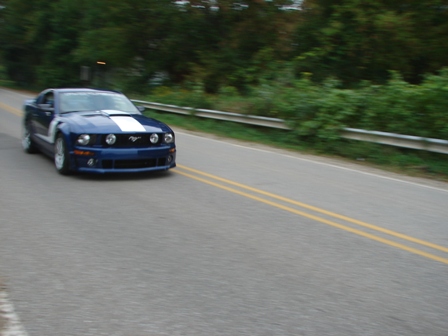
Ford's Mustang is wildly popular, but as is the case with any vehicle that sells over a quarter-million copies each year, there will be compromises that prevent the "one percenters" from being truly satisfied. That's where ROUSH Performance Products steps in, with its Stage upgrades, and now the 427R - intended to slot between the Stage 2 and Stage 3 in both price and performance.
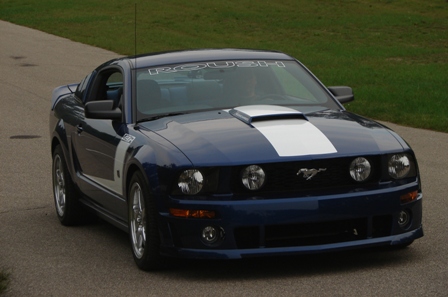
The 427R is based upon a Mustang GT Coupe Deluxe, which includes leather seats (with a 6-way power adjuster and lumber support on the driver's side), cruise control, keyless entry, A/C, power locks, power windows with auto-up/-down, and power mirrors. The Shaker 500 sound system is also included. With this as a starting point, the vehicle then undergoes extensive modification.
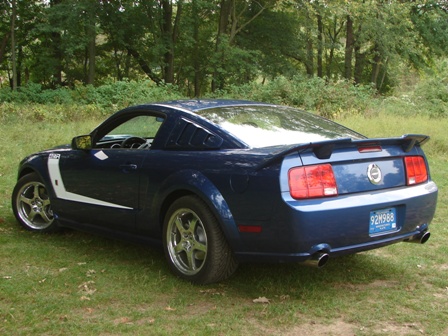
Drivetrain
The heart of the 427R's modifications is the ROUSHcharger forced-induction system that is installed on the 3-valve SOHC 4.6L V8. Utilizing an Eaton positive-displacement supercharger and a water-to-air intercooler integrated into the intake manifold, the system applies approximately 6 PSI of boost to produce 427 HP and 391 lb-ft - a useful increase of 127 HP and 71 lb-ft over the stock numbers. The system includes a vacuum-actuated bypass valve that routes air around the compressor at part throttle to increase efficiency. A heat exchanger for the intercooler is nestled behind the front fascia and uses a dedicated coolant loop (plumbed along the passenger's side of the engine) with an electric circulation pump. The engine's new fuel and spark demands are satisfied via a recalibrated OEM powertrain control module. Premium fuel is required, of course. The stock exhaust manifolds and catalytic converters dump spent gases into the ROUSH stainless-steel cat-back system.
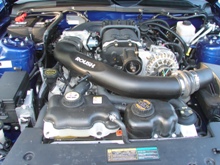
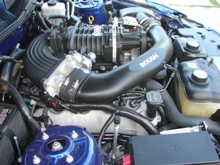
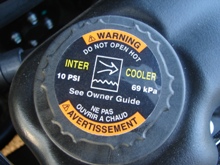
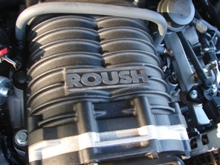
Bumping up the output by nearly 43% changes the Mustang's personality dramatically, with the blower providing loads of thrust at any RPM and in any gear. The tractability and linearity of the powerplant is remarkable, giving the operator absolute control over the amount of power that reaches the rear wheels. This is good, as applying too much throttle with the traction control disabled will simply light up the rear tires in First, and some caution should be exercised in Second as well.
Great sounds are generated along as soon as the starter is engaged, with the PCM bringing up the revs to about 2000 RPM during start-up to produce a healthy bark before settling down to the normal idle speed. Putting the pedal to the floor fills the cabin with a thundering exhaust note, complimented by the supercharger's lovely mechanical whine. On decel, a symphony of crackles and growls is sung by the 3" tips that peek out from under the rear fascia. It's a wonderful soundtrack that totally fits the personality of the car, but forget any notion of sneaking around - heads will turn as the 427R passes by. If we have a complaint, it's that a rather obnoxious drone is emitted at part throttle around 1800 RPM. Downshift a gear and the exhaust note becomes much more pleasant; it's a solution that we're quite comfortable recommending.
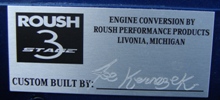

Suspension
The performance modifications continue to the underpinnings, where ROUSH replaces the factory springs, sway bars, front struts, rear shocks, bushings, and jounce bumpers with new components to lower the Mustang while providing improved roll resistance. It appears that additional camber and caster is also dialed into the front suspension.
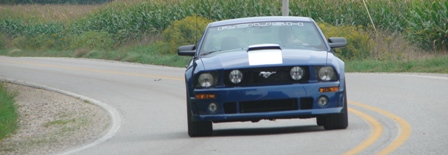
All of these blue powdercoated parts combine with the stiff S197 structure to add up to what is easily the best ride-vs.-handling compromise we've ever experienced in a pony car. The increased roll rate and lowered center-of-gravity provide crisp handling with neutral breakaway characteristics, and yet the suspension remains compliant enough to handle the worst of Michigan's pothole-strewn roads. Never does the rear axle give any indication of tramp or hop, and in fact behaves better than some RWD vehicles with independent rear suspension. Quite simply, every musclecar should handle this well. If we were to change anything, we'd perhaps try to dial in a bit more steering feedback, as it retains the stock Mustang's slightly overboosted feel.
Wheels and tires
Five-spoke chromed cast-aluminum 18x9" wheels are wrapped in Cooper Zeon 2XS directional tires in 275/40-18. We had no previous experience with this tire, but came away impressed by its respectable dry and wet traction (the latter of which we had a disproportionate amount of time experiencing due to the wet weather this fall). Additionally, the low noise and decent ride quality were appreciated when we weren't driving at 10/10ths. Almost as importantly, the wheel/tire package did a great job of complimenting the lowered ride height by filling up the fenderwells.
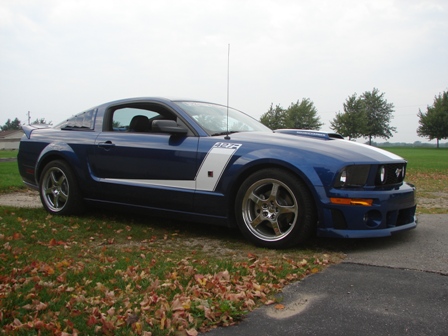
Body
While the supercharger and underpinnings are responsible for providing the "go", ROUSH's exterior appearance modifications supply plenty of "show". A color-matched four-piece body kit is installed, consisting of a redesigned front fascia and air dam, nonfunctional hood scoop, and "whale tail" rear spoiler. The 427R package also includes louvered covers for the quarter windows. A racing stripe covers the center of the hood and scoop, while "hockey-stick" graphics run down the front fenders and doors and a large ROUSH banner adorned the top of the windshield. Several other badges leave no question about the 427R's origin. Combined with the lowered ride height, the effect is that of a race car that has escaped from pit row to terrorize the streets.
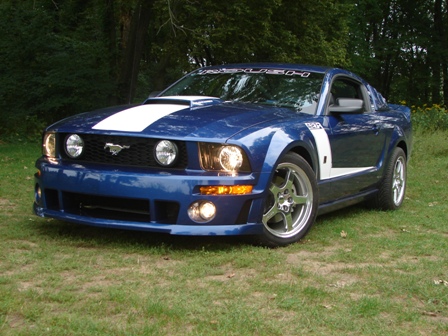
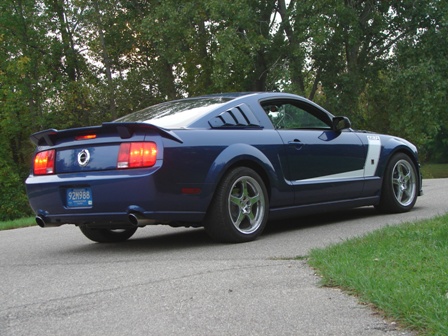
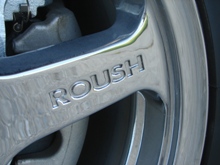
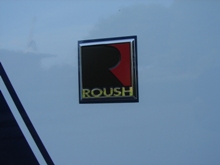
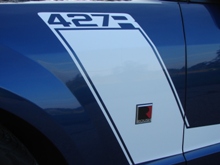
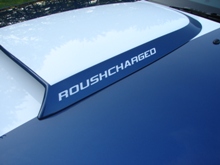
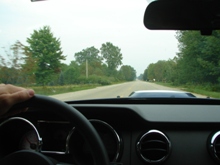
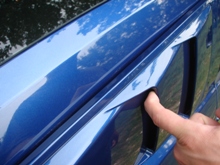
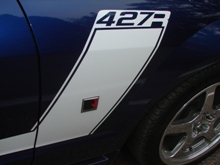
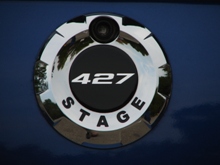
The cosmetic changes turn the Mustang into a total attention magnet. We've never experienced such a reaction from any vehicle we've ever driven; people respond to the 427R with the joy that one would expect from a childhood automotive fantasy come to life. We also found that the Roush name carries with it a substantial amount of "street cred". If you like getting the thumbs-up sign from random strangers and talking about cars every time you pull into a parking spot, this is your car. Those looking to fly under the radar would be well-advised to seek alternative transportation.
The body add-ons also fit the Mustang extremely well, with the exception of the side window louvers. Held on by only three screws, they were able to move around a bit. While this didn't create any noise, we think that it might scuff the paint after a while, and would have preferred to see a bit of double-sided tape to help keep them from rubbing on the finish. Otherwise, the quality of the exterior parts was excellent and we never scraped the air dam, proving that ROUSH designed these components for real-world use.
Interior
To spice up the normally dark and dour Mustang interior, new seat covers with electric-blue perforated leather inserts are installed onto the stock frames and cushions. Down below, billet aluminum pedal covers are installed, including a dead pedal, and a set of ROUSH embroidered floor mats cover the carpet. A custom gauge black-on-white gage cluster is installed into the dashboard as well. To top things off, a billet aluminum shift knob is mounted atop the stock shifter.
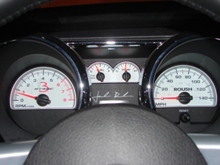
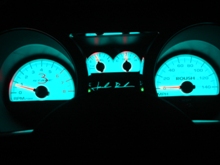
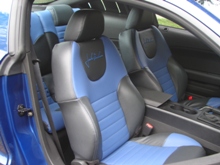
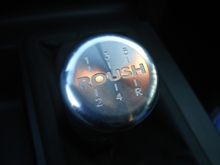
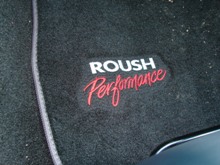

The blue seats certainly match up well with the exterior, but admittedly they're slightly jarring at first sight when contrasted with the rest of the interior. We initially thought that we wouldn't like the pedal covers, thinking that they'd be too slippery when wet. Fortunately, their sharp edges provided plenty of grip, heal-and-toe downshifts were possible, and we found the dead pedal to be perfectly placed. The shape of the shift knob also drew some early scrutiny, but it turned out to be well-matched to the placement of the shifter and center console. The new gage cluster proved easy to read and the green night time backlighting was well-matched with other controls, but the MyColor feature of the OEM cluster is lost in the process. Also, the redline on the tach is marked at 6000 RPM, where the power peak hasn't yet arrived and the rev limiter doesn't kick in for another 500 RPM.
Warranty
Those who are concerned about the effect of these modifications upon the factory warranty need not worry - all of the Ford factory equipment is still covered. ROUSH components carry their own 3-year/36,000-mile warranty.
Performance
When dealing with this much power, putting down the hammer on public roads fails to provide any meaningful indication of performance (not to mention the danger presented to the general public and our driver licenses). To provide some objective measurements, we first hit a chassis dyno to see if ROUSH's claims could be verified, and then took several passes down the dragstrip.
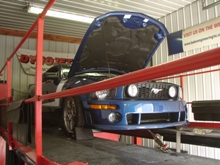
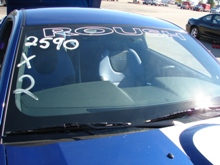
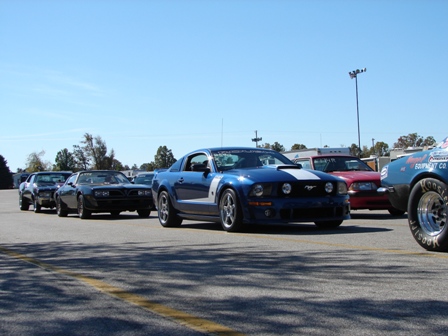
We brought the 427R over to Baker Engineering in Nunica, MI and strapped it to the facility's Dynojet 248 inertial chassis dyno. Our first run resulted in some disappointing numbers, but an hour of diagnosis by ROUSH technicians revealed a simple problem - the blower's bypass valve actuator was misadjusted, causing the valve to remain partially open at wide-open throttle. The effect of this was to bleed off nearly half of the blower's boost, with a corresponding effect on power production. Spinning up the rollers once again, we obtained a rather healthy 356 HP and 330 lb-ft of torque at the rear wheels (corrected for atmospheric conditions to the SAE J1349 standard, of course). Assume a drivetrain loss figure of somewhere around 15-20% (trying to pin down an exact number is impossible), and these results back up ROUSH's crankshaft ratings. The engine was still pulling hard when the rev limiter was encountered at 6500 RPM, and the torque curve remained healthy over the entire range of the pull.
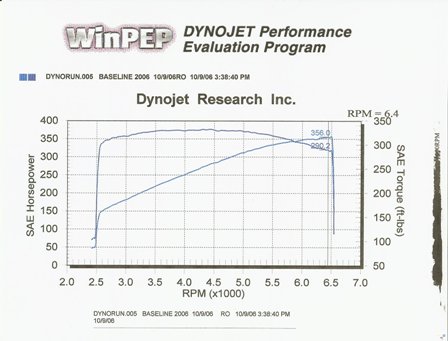
We then drove the 427R over to Mid-Michigan Motorplex in Stanton, MI to lay down some passes. Hampered by difficulties with wheelspin, our quickest attempt resulted in an elapsed time of 13.474 seconds at 106.79 MPH (a faster trap speed of 107.28 was recorded on a 13.551 pass). Applying NHRA correction factors for weather - we calculated a density altitude of 1600 ft - to our quickest run yields 13.234@108.77 MPH (we give you both the raw and corrected numbers, as opinions vary as to which is the more useful figure). While the trap speeds are appropriate for the 427R's power-to-weight ratio, the elapsed times were several tenths slower than what we'd like to see. A glance at the timeslip shows the problem; with a 60-foot time of 2.040, we spent way too much time trying to ease the car out of the hole without boiling the tires or bogging the engine (launching at 2500 RPM was the way to avoid excessive wheelspin, even with the tires at 25 PSI). We also struggled a bit with the stock shifter, and think that ROUSH's optional billet shifter would be money well spent for aspiring drag racers. Finally, the overaggressive rev limiter seems to shut down the engine for an eternity (in reality, it kills the motor for about a second), which applies a stiff penalty to late shifts. Bolt on a set of drag radials, get in some more practice with the shifter, and we think that this thing will easily break into the twelves.
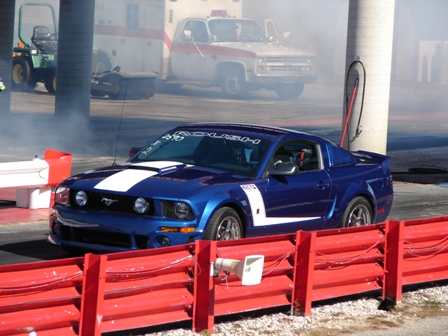
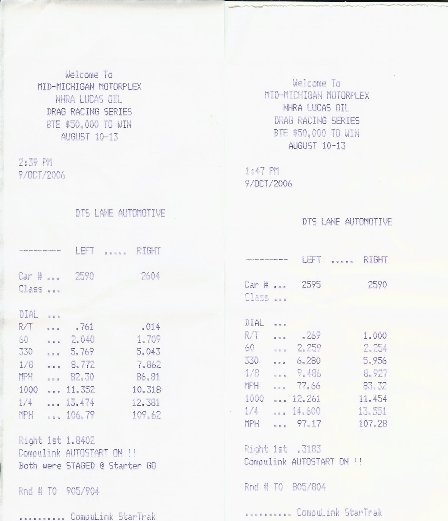
The Final Verdict
Judged solely upon its merits, we think that that ROUSH 427R is indeed a fine piece of performance machinery - and an attractive piece of eye candy, as well. However, it's a fact of life that ROUSH expects some payment in return for all of this equipment, and the base 427R package adds $15,000 to the Mustang GT's MSRP of $26,980. The gage cluster, custom leather seating, and side window louvers add another $2,340, and Uncle Sam grabs another grand for the federal gas-guzzler tax. Add in the delivery cost, and it'll take $46,110 to put one in your driveway.
This places the 427R in the same price range as Ford's own Shelby GT500, as well as the base version of Chevrolet's Corvette. To be honest, it's unlikely that the Vette will be cross-shopped against either Mustang (it's a Ford vs. Chevy thing, folks), so the real competition here is indeed the Blue Oval's factory hot rod. In the Shelby's favor is an additional 75 HP, as well as larger brakes. Thanks to its smaller aluminum block engine, though, the 427R is lighter by a couple hundred pounds (and with much better distribution of that mass), and we think that it's far less likely to be mistaken for a garden-variety Mustang. And let's not forget the "market adjustment" currently applied to the GT500 (although that is likely a temporary situation). We'll hold off on forming too strong of an opinion until we get to spend some serious time with the Shelby, but our tendency right now might be to select the GT500 for serious straight-line duty, and go with the 427R for just about anything else. It's not cheap, but it's a well-engineered muscle car that's equally at home on the street or the racetrack, and we thoroughly enjoyed our time with it in the Autoblog Garage.
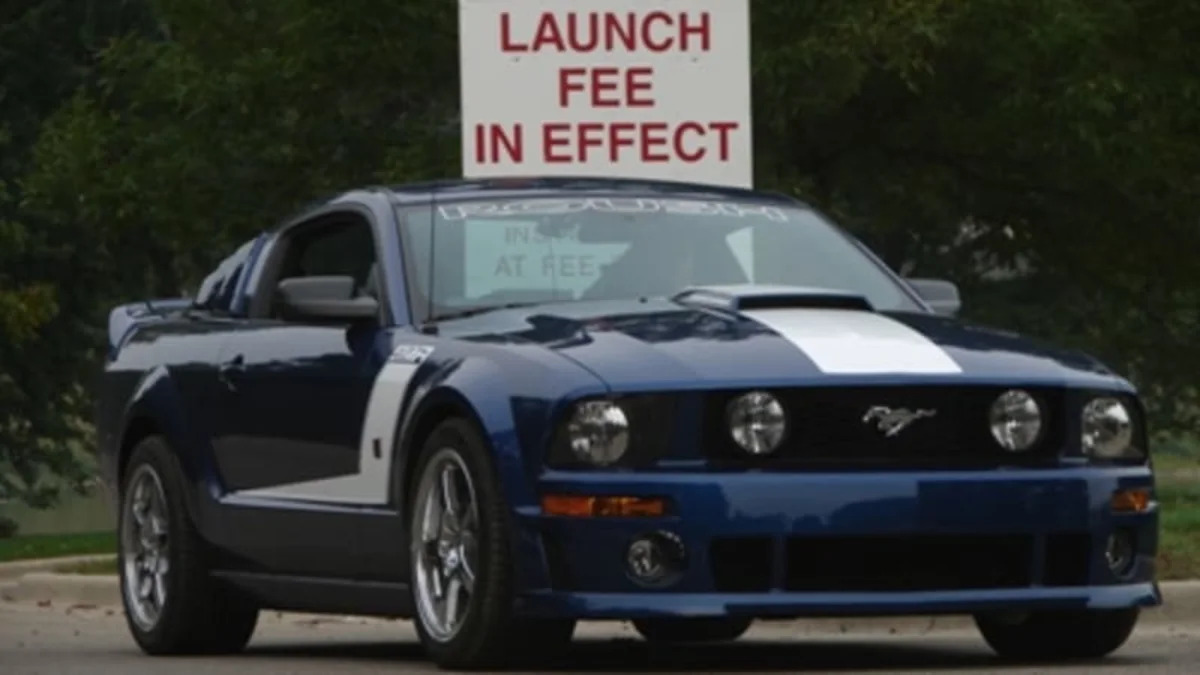

Sign in to post
Please sign in to leave a comment.
Continue